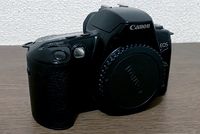Canon Canonet QL19 is my first classic camera.
As I wrote in a past post, I like to "treasure hunts" in the second-hand store junk corner.
August 2019.
I found the Canon Canonet QL19, an individual that has aged scratches and stains but looks reasonably good.
I looked at the price tag, it was 1,000 yen (tax out).
I confirmed that the shutter speed, aperture, film winding advance lever, and shutter release button.
At that moment, I decided to buy Canonet QL19.
When I was researching Canonet, I found that there was a backlash from the camera industry when Canonet was released.
That is also mentioned on the official website.
[Reference]: Canonet - Canon Camera Museum
In summary, The camera industry opposed that the selling price is too low for the Canonet's function, but Canon released Canonet, as a result, the public favored Canon, and Canonet sold so well, it left a name in history.
And, "Canonet QL19" is the successor to the "Canonet".
[Reference]: Canonet QL19 - Canon Camera Museum
Impression that heavier than it looks.
The lens is SE45mm F1.9.
This is the same lens as the Canonet first model.
By the way, there are cameras named "QL17" and "QL25", but the biggest difference in the specifications is the open F value of the aperture.
Model name number ÷ 10 = open F value, which is easy to understand.
I thought QL17 would be better, but it was my destiny to buy QL19.
If you are unsure about how to identify the Canonet series, please refer to the link below.
[Reference]: Search by Canonet - Camera Hall - Canon Camera Museum
I was impressed by the smooth movement of the Advance Lever.
This was the first time I've experienced focusing with "rangefinder".
Among them, I think the Canonet QL19 is an easy-to-use category.
One of the reasons is the film Quick Loading (QL) system.
As you can see, the model name "QL" is an abbreviation for "Quick Loading".
Focus ring, shutter speed ring, aperture ring, aperture auto canceling lever, X/M switching lever, self-timer lever, ASA/DIN setting lever ...
The operation of the left hand gets busy. :}
The only thing I haven't confirmed is whether the exposure meter and shutter speed-priority EE work.
It requires batteries, but the batteries mentioned in the specifications are no longer able to get.
There seem to be various alternatives, but I haven't tried it yet.
There are some parts that I haven't confirmed, but I was surprised and impressed that the camera, which was released in March 1965 and is much older than me, worked smoothly without any problems.
Since I had an encounter with this classic camera, at a later, I was able to meet my dearest camera.
I will post an article about it at a later date.
The shooting results is the next post. :)


